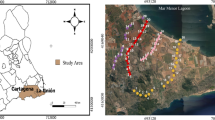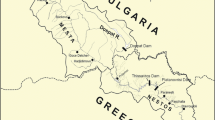Abstract
A three-dimensional interpolation method based on a digital elevation model (DEM) was developed to assess the impact of mining and metallurgical activity on the Claro River (Hidalgo, Mexico). This method was used to analyze the spatial concentration of manganese in sediments, water, and fish (viscera and muscle). Input data correspond to chemical manganese (Mn) analysis of the aforementioned environmental matrices, mining discharge volumes, and rainfall data. The three-dimensional model made it possible to (a) define Mn dispersion (19 km for sediments and 13 km for viscera); (b) identify northern meanders of the Claro River as areas of Mn accumulation in sediments and fish; and (c) determine river features that influence Mn concentration in fish. Results indicate that Mn concentration increases in areas receiving industrial discharges, as well as in meanders located near Acuimantla village. Total Mn levels in the water are between < 0.01 and 6.57 mg/L, while soluble and colloidal Mn concentrations range from < 0.01 to 0.49 mg/L. The highest Mn values in the water (total Mn: 6.57 mg/L and soluble-colloidal Mn: 0.49 mg/L) were detected in tributary rivers near industrial discharge sites. The concentration in water compared with that in sediments (160–213,867 mg/kg) and fish (viscera: 5–5236 mg/kg and muscle: 10.7–398.8 mg/kg) indicates low solubility of this mineral. The geoaccumulation index (Igeo) and contamination factor (CF) show that sediment composition has been affected.






Similar content being viewed by others
References
Agency for Toxic Substances and Disease Registry (ATSDR) (2012) Toxicological profile for Mn. US Department of Health and Human Services, Public Health Service, Agency for Toxic Substances and Disease Registry, 556 p. Retrieved from https://www.atsdr.cdc.gov/ToxProfiles/tp151.pdf
Autlán (2020) Autlán manganeso. Retrieved from https://www.autlan.com.mx/negocios/autlan-manganeso/
Bjorklund G, Chartrand MS, Aaseth J (2017) Manganese exposure and neurotoxic effects in children. Environ Res 155:380–384
Bowler RM, Beseler CL, Gocheva VV, Colledgec M, Kornblith ES, Julian JR, Kim Y, Bollweg G, Lobdel DT (2016) Environmental exposure to manganese in air: associations with tremor and motor function. Sci Total Environ 541:646–654
Carvalho CF, Oulhote Y, Martorelli M, Menezes-Filho JA, Argollo N, Abreu N (2018) Environmental manganese exposure and associations with memory, executive functions, and hyperactivity in Brazilian children. Neurotoxicology 69:253–259
Environmental Protection Agency (EPA) (1992). Method 3050A. Acid digestion of sediments, sludges and soils. 6 p. Retrieved from http://legismex.mty.itesm.mx/secc_inter/SW-846/3050a.pdf
Environmental Protection Agency (EPA) (2007a) Method 6200. Field portable x-ray fluorescence spectrometry for the determination of elemental concentrations in soil and sediment, 32 p. Retrieved from https://www.epa.gov/sites/production/files/2015-12/documents/6200.pdf
Environmental Protection Agency (EPA) (2007b) Method 3015A (SW-846): microwave assisted acid digestion of aqueous samples and extracts, Revision 1. Washington, DC. Retrieved from https://www.epa.gov/sites/production/files/2015-12/documents/3015a.pdf
Environmental Protection Agency (EPA) (2007c) Method 6010C (SW-846): inductively coupled plasma-atomic emission spectrometry, Revision 3. Retrieved from https://19january2017snapshot.epa.gov/sites/production/files/2015-07/documents/epa-6010c.pdf
Finley JW, Penland JG, Pettit RE, Davis CD (2003) Dietary manganese intake and type of lipid do not affect clinical or neuropsychological measures in healthy young women. J Nutr 133(9):2849–2856
Greger JL (1998) Dietary standards for manganese: overlap between nutritional and toxicological studies. J Nutr 128(2 Suppl):368S–371S
Gutiérrez-Ruiz M (Coord) (2017) Informe Final. Estudio ambiental del Distrito Manganesífero de Molango, Hidalgo, México (Etapa I) Laboratorio de Biogeoquímica Ambiental, Facultad de Química UNAM, 326 p
Gutiérrez-Ruiz M (Coord) (2019) Informe Final. Estudio ambiental del Distrito Manganesífero de Molango, Hidalgo, México (Segunda Etapa) Laboratorio de Biogeoquímica Ambiental, Facultad de Química UNAM, 87 p
Higdon J (2001) Manganese. Minerals. Micronutrient Information Center. Linus Pauling Institute, Oregon State University. Retrieved from https://lpi.oregonstate.edu/mic/minerals/manganese
Instituto Nacional de Estadística y Geografía (INEGI) (2018) Curvas de nivel escala 1:50,000: F14C29, F14C39, F14C49, F14C59, F14C69, F14D21, F14D31, F14D41, F14D51, F14D61, F14D22, F14D32, F14D42, F14D52, F14D62
Jephcote C, Chen H (2013) Geospatial analysis of naturally occurring boundaries in road-transport emissions and children’s respiratory health across a demographically diverse cityscape. Soc Sci Med 82:87–99
Kerfoot WC, Urban NR, McDonald CP, Zhang H, Rossmann R, Perlinger JA, Khan T, Hendricks A, Priyadarshini M, Bolstad M (2018) Mining legacy across a wetland landscape: high mercury in Upper Peninsula (Michigan) rivers, lakes, and fish. Environ Sci Environ Sci Processes Impacts 20(4):708–733
Lee E-Y, Flynn MR, Lewis MM, Mailman RB, Huang X (2018) Welding-related brain and functional changes in welders with chronic and low-level exposure. Neurotoxicology. 64:50–59
Matejicek L (2005) Spatial modelling of air pollution in urban areas with GIS: a case study on integrated database development. Adv Geosci Eur Geosci Union 4:63–68
Mergler D, Huel G, Bowler R, Iregren A, Belanger S, Baldwin M, Tardif R, Smargiassi A, Martin L (1994) Nervous system dysfunction among workers with long-term exposure manganese. Environ Res:151–180
National Institutes of Health (NIH) (2020) Manganese. Fact Sheet for Health Professionals. National Institutes of Health. U.S. Department of Health & Human Services. Retrieved from https://ods.od.nih.gov/factsheets/Manganese-HealthProfessional/
Nowrouzi M, Pourkhabbaz A (2014) Application of geoaccumulation index and enrichment factor for assessing metal contamination in the sediments of Hara Biosphere Reserve, Iran. Chem Speciat Bioavailab 26(2):99–105
Ntihabose R, Surette C, Foucher D, Clarisse O, Bouchard MF (2018) Assessment of saliva, hair and toenails as biomarkers of low-level exposure to manganese from drinking water in children. Neurotoxicology 64:126–133
O’Gorman L (1990) k × k thinning. J Comput Vision Graph Image Process 51(2):195–215
Parrot J-F (2006) TLALOC (Tridimensional Landscape Analysis and Local Operating Computation) Copyright INDAUTOR: 03-2006-092112451400-01.
Parrot J-F (2007) Tri-dimensional parameterisation: an automated treatment to study the evolution of volcanic cones. Géomorphologie. 3:37–47
Parrot J-F (2016) Generación de MDE a partir de datos vectoriales. Paquete de Módulos Ejecutables desarrollados en C++. Copyright INDAUTOR: 03-2016-103110072200-01
Parrot J-F, Ramírez-Núñez C (2019) Difusión de la contaminación en un cauce. Manual de utilización de los algoritmos generados para la difusión de contaminantes en el espacio tridimensional. Copyright INDAUTOR: 03-2019-031911402300-01
Popoola SO, Ibitola MP, Appiah YP, Imhansoeleva TM (2015) Geochemical and statistical approach to assessing trace metal accumulations in Lagos Lagoon Sediments, South Western, Nigeria. J Geogr Environ Earth Sci Int, 393 3(4):1–16
Rimon Y, Graber ER, Furman A (2013) Interpolation of extensive routine water pollution monitoring datasets: methodology and discussion of implications for aquifer management. Hydrol Earth Syst Sci Discuss 10(7):9363–9387
Santamaría AB, Cushing CA, Antonini JM, Finley BL, Mowat FS (2007) State-of-the-science review: does Mn exposure during welding pose a neurological risk? J Toxicol Environ Health B 10(6):417–465
Servicio Meteorológico Nacional (SMN) (2018) Estación Tlanchinol, Hidalgo (13048). Retrieved from https://smn.cna.gob.mx/tools/RESOURCES/Normales5110/NORMAL13048.TXT
Srivastava P, Gupta M, Mukherjee S (2012) Mapping spatial distribution of pollutants in groundwater of a tropical area of India using remote sensing and GIS. Appl Geomatics 4:21–32
Taud H, Parrot J-F, Álvarez R (1999) DEM generation by contour line dilation. Comput Geosci 25:775–783
Zamora Martínez O, Martín-Romero F, Lozano Santa Cruz R (2008) Evaluación del desempeño de un analizador portátil de Fluorescencia de Rayos X en la determinación de la composición elemental de residuos mineros. Geos 28(2):161–162
Zoni S, Lucchini RG (2013) Manganese exposure: cognitive, motor and behavioral effects on children: a review of recent findings. Curr Opin Pediatr 25(2):255–260
Zoni S, Albini E, Lucchini R (2007) Neuropsychological testing for the assessment of manganese neurotoxicity: a review and a proposal. Am J Ind Med 50(11):812–830
Acknowledgments
We are thankful to Dr. Suarez for the facilities provided for carrying out this project with the collaboration of academics of the Institute of Geography, to Agueda Ceniceros Gómez for her advice, to Reyna Roldán and Esaú Jiménez for their support on the chemical analysis, and, finally, to Helen Ponce Wainer for language revision and correction. We also thank all the reviewers for comments and suggestions.
Funding
The authors declare that, simultaneously to the development of this study, a project for an industrial client (Autlán. S.A.B de C.V) was done. The company funded the sampling and the chemical analysis of water, sediment, and fishes.
Author information
Authors and Affiliations
Contributions
MGR, LPM, DAR, and LJM realized sample collection and chemical analysis; JFP and CRN developed the proposed hydric dispersion model. All the authors contributed to the analysis and results, read, and approved the final manuscript.
Corresponding author
Ethics declarations
Ethical approval and consent to participate
Not applicable.
Consent to publish
Not applicable.
Disclaimer
The development and application of the model, results, interpretation, and preparation of this manuscript are solely those of the authors.
Additional information
Responsible Editor: Philippe Garrigues
Publisher’s note
Springer Nature remains neutral with regard to jurisdictional claims in published maps and institutional affiliations.
Rights and permissions
About this article
Cite this article
Gutiérrez-Ruiz, M., Parrot, JF., Ramírez-Núñez, C. et al. Tridimensional spatial distribution of manganese in a river impacted by metallurgical activity and mining. Environ Sci Pollut Res 28, 3494–3505 (2021). https://doi.org/10.1007/s11356-020-10727-x
Received:
Accepted:
Published:
Issue Date:
DOI: https://doi.org/10.1007/s11356-020-10727-x




